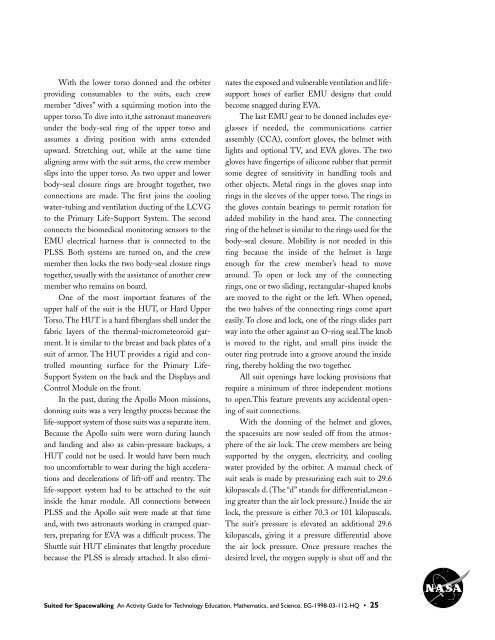Suited for Spacewalking pdf - Virtual Astronaut
Suited for Spacewalking pdf - Virtual Astronaut
Suited for Spacewalking pdf - Virtual Astronaut
- No tags were found...
Create successful ePaper yourself
Turn your PDF publications into a flip-book with our unique Google optimized e-Paper software.
With the lower torso donned and the orbiterp roviding consumables to the suits, e a ch crewmember “dives” with a squirming motion into theupper torso.To dive into it,the astronaut maneuversunder the body-seal ring of the upper torso andassumes a diving position with arms extendedupward. Stretching out, while at the same timealigning arms with the suit arms, the crew memberslips into the upper torso. As two upper and lowerbody-seal closure rings are brought together, twoconnections are made. The first joins the coolingwater-tubing and ventilation ducting of the LCVGto the Primary Life-Support System. The secondconnects the biomedical monitoring sensors to theEMU electrical harness that is connected to thePLSS. Both systems are turned on, and the crewmember then locks the two body-seal closure ringstogether, usually with the assistance of another crewmember who remains on board.One of the most important features of theupper half of the suit is the HUT, or Hard UpperTorso. The HUT is a hard fiberglass shell under thefabric layers of the thermal-micrometeoroid garment.It is similar to the breast and back plates of asuit of armor. The HUT provides a rigid and controlledmounting surface <strong>for</strong> the Primary Life-Support System on the back and the Displays andControl Module on the front.In the past, d u ring the Ap o llo Moon mission s ,d onning suits was a ve ry lengthy process because thel i fe - s u p p o rt system of those suits was a separate item.B e cause the Ap o llo suits were worn during launchand landing and also as ca b i n - p re s s u re back u p s , aHUT could not be used. It would have been mu chtoo uncom f o rtable to wear during the high accelerati ons and decelera t i ons of lift-off and re e n t ry. T h el i fe - s u p p o rt system had to be attached to the suitinside the lunar module. A ll con n e c t i ons betw e e nPLSS and the Ap o llo suit were made at that timea n d , with two astronauts working in cramped quarte r s , p re p a ring <strong>for</strong> EVA was a difficult pro c e s s . T h eShuttle suit HUT eliminates that lengthy pro c e d u reb e cause the PLSS is already attach e d . It also eliminatesthe exposed and vulnerable ve n t i l a t i on and life -s u p p o rt hoses of earlier EMU designs that couldb e c ome snagged during EVA .The last EMU gear to be donned includes eyeglassesif needed, the com mu n i ca t i ons ca r ri e rassembly (CCA), com<strong>for</strong>t gloves, the helmet withlights and optional TV, and EVA gloves. The twogloves have fingertips of silicone rubber that permitsome degree of sensitivity in handling tools andother objects. Metal rings in the gloves snap intorings in the sleeves of the upper torso. The rings inthe gloves contain bearings to permit rotation <strong>for</strong>added mobility in the hand area. The connectingring of the helmet is similar to the rings used <strong>for</strong> thebody-seal closure. Mobility is not needed in thisring because the inside of the helmet is largeenough <strong>for</strong> the crew member’s head to movearound. To open or lock any of the connectingrings, one or two sliding, rectangular-shaped knobsare moved to the right or the left. When opened,the two halves of the connecting rings come aparteasily. To close and lock, one of the rings slides partway into the other against an O-ring seal.The knobis moved to the right, and small pins inside theouter ring protrude into a groove around the insidering, thereby holding the two together.All suit openings have locking provisions thatrequire a minimum of three independent motionsto open.This feature prevents any accidental openingof suit connections.With the donning of the helmet and gloves,the spacesuits are now sealed off from the atmosphereof the air lock. The crew members are beingsupported by the oxygen, electricity, and coolingwater provided by the orbiter. A manual check ofsuit seals is made by pressurizing each suit to 29.6kilopascals d. (The “d” stands <strong>for</strong> differential,meaninggreater than the air lock pressure.) Inside the airlock, the pressure is either 70.3 or 101 kilopascals.The suit’s pressure is elevated an additional 29.6kilopascals, giving it a pressure differential abovethe air lock pressure. Once pressure reaches thedesired level, the oxygen supply is shut off and the<strong>Suited</strong> <strong>for</strong> <strong>Spacewalking</strong> An Activity Guide <strong>for</strong> Technology Education, Mathematics, and Science, EG-1998-03-112-HQ • 2 5
















